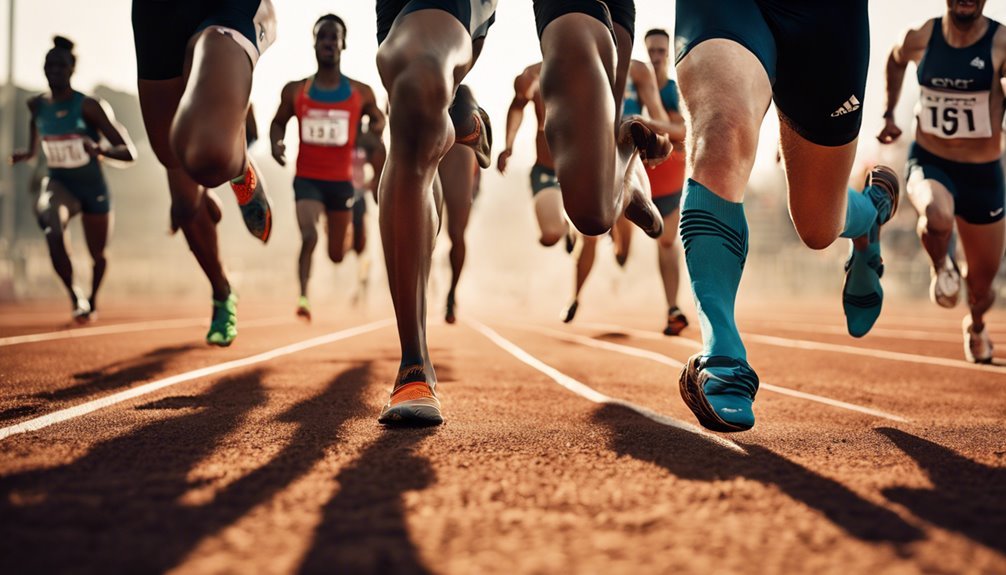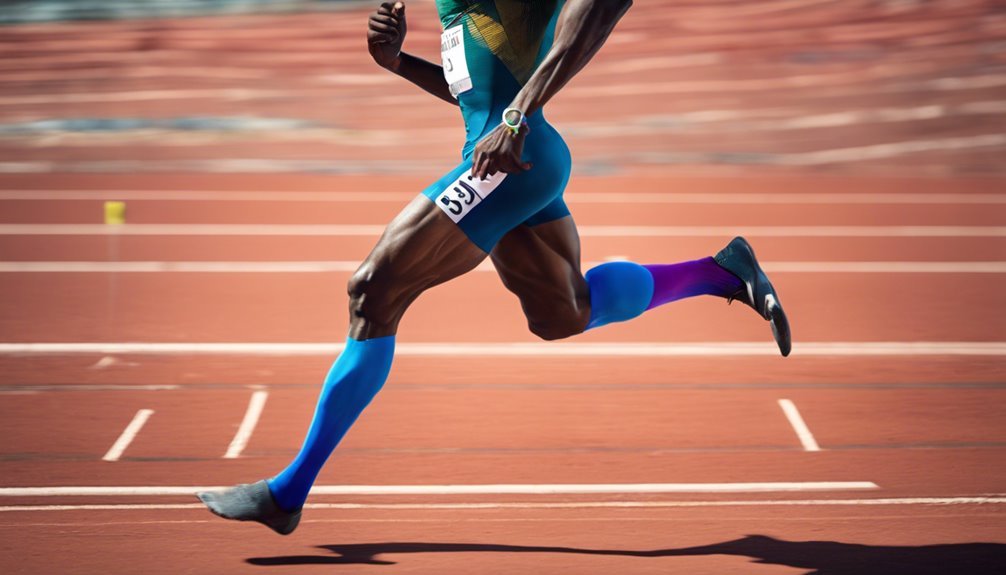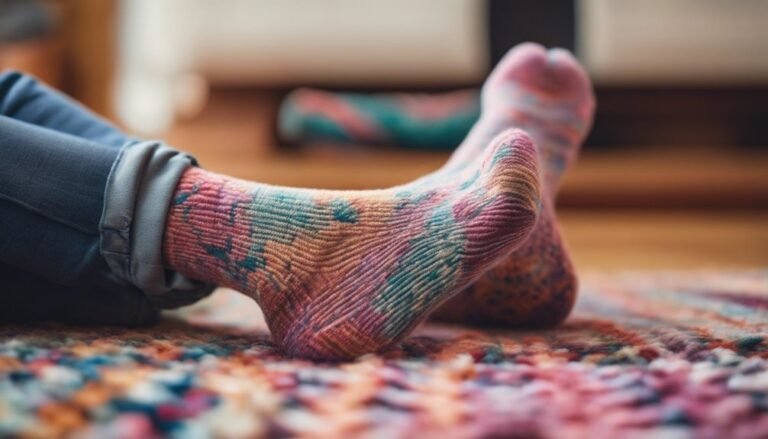Do Compression Socks Improve Athletic Performance?
Compression socks can enhance athletic performance by increasing blood flow and oxygen delivery to your muscles. They apply graduated pressure, which also reduces muscle vibration and fatigue during activities. However, research shows mixed results, with some athletes reporting improved endurance, while others see minimal benefits. Individual variability means they might not work for everyone. If you want to explore potential drawbacks and how to select the right socks, you might find further insights beneficial.
Understanding Compression Socks: What Are They?

Compression socks are specialized garments designed to apply graduated pressure to the lower extremities, promoting better blood circulation. You'll find various compression types, including mild, moderate, and high levels of support, tailored for different needs. The choice of sock materials—such as nylon, spandex, and cotton—plays an essential role in comfort and effectiveness. These materials not only enhance durability but also allow moisture-wicking properties, keeping your feet dry during physical activities. By understanding these elements, you can select the right compression socks that align with your performance goals. This knowledge empowers you to make informed decisions, ultimately enhancing your athletic experience while prioritizing your well-being and freedom in movement.
The Science Behind Compression: How They Work
When you wear compression socks, the graduated pressure they exert plays an essential role in enhancing venous return and reducing muscle fatigue. This pressure gradient is highest at the ankle and gradually decreases up the leg, effectively promoting blood flow back to the heart. By providing targeted muscle support, compression socks help maintain ideal circulation during physical activity. Enhanced venous return facilitates more efficient oxygen delivery to your muscles, potentially improving endurance. Studies suggest that this mechanism can contribute to quicker recovery post-exercise. Consequently, wearing compression socks isn't just about comfort; it's a strategic choice to enhance your performance and minimize fatigue through scientifically-backed principles of hemodynamics and muscle support.
Potential Benefits of Wearing Compression Socks
The benefits of wearing compression socks extend beyond just comfort and support; they can greatly impact athletic performance and recovery. By enhancing circulation, these socks may facilitate performance enhancement and speed up recovery times. Here are some potential advantages:
- Improved blood flow, leading to better oxygen delivery to muscles
- Reduced muscle vibration, which can decrease fatigue
- Enhanced lymphatic drainage, aiding in toxin removal
- Decreased risk of injury by providing additional support
- Faster recovery post-exercise, allowing for more frequent training
With these benefits, you can experience a noticeable difference in your athletic endeavors. As you aim for excellence, consider how compression socks might provide the edge you need to optimize your performance and maintain your freedom to pursue your athletic goals.
Examining the Research: Do They Actually Improve Performance?

How effective are compression socks in enhancing athletic performance? Recent evidence analysis suggests that while compression socks may improve blood flow and reduce muscle oscillation, their impact on performance metrics remains inconclusive. Some studies indicate enhanced endurance in long-distance runners, while others show minimal effect on sprinting or strength activities. The diversity in findings highlights the need for more rigorous research. It's essential to evaluate individual variability; what works for one athlete might not for another. Ultimately, if you're seeking a measurable boost in performance, the current evidence doesn't definitively support compression socks as a game-changer. Instead, they may serve better as a supplementary tool rather than a primary performance enhancer.
Recovery and Compression: The Post-Workout Advantage
While compression socks may not greatly enhance athletic performance during activities, their role in post-workout recovery warrants attention. By improving blood circulation, these socks can facilitate muscle recovery, helping you bounce back faster after intense workouts.
Here are some benefits of using compression socks during recovery:
- Reduces muscle soreness
- Enhances venous return
- Minimizes swelling and inflammation
- Promotes nutrient delivery to muscles
- Accelerates the removal of metabolic waste
Utilizing compression socks post-exercise can be a strategic choice for athletes seeking to optimize their recovery process. By providing consistent compression, they help maintain blood circulation, making your recovery more efficient and effective, ultimately allowing you to enjoy greater freedom in your training regimen.
Potential Drawbacks and Considerations
While compression socks can offer benefits, it's important to take into account the risk of over-reliance, which could hinder your body's natural recovery processes. Additionally, some users report discomfort during use, which may affect performance rather than enhance it. Evaluating these factors is vital for making an informed decision about incorporating compression socks into your athletic routine.
Risk of Over-Reliance
Although compression socks are often hailed for their benefits in enhancing athletic performance and recovery, over-reliance on them can lead to potential drawbacks that athletes should consider. This over-dependence can skew performance expectations and may inadvertently hinder natural adaptation processes. Here are some consequences to keep in mind:
- Reduced focus on proper warm-up and cool-down routines
- Potential neglect of strength and conditioning work
- Increased risk of injury if used as a crutch
- Diminished body awareness and proprioception
- Psychological dependency on external aids for performance
Potential Discomfort During Use
When using compression socks, you might experience some discomfort that can affect your performance and overall experience. Discomfort levels can vary based on sock fit; if the socks are too tight or the wrong size, they may constrict blood flow rather than enhance it. This can lead to sensations of pain, numbness, or excessive heat, which could distract you during physical activities. It's important to choose the right fit based on your foot and calf measurements to mitigate these issues. Additionally, wearing compression socks for extended periods without breaks can exacerbate discomfort, making it vital to listen to your body. Ultimately, prioritizing comfort alongside performance benefits is key to an enjoyable athletic experience.
How to Choose the Right Compression Socks for You
Choosing the right compression socks can greatly impact your athletic performance and recovery, as the appropriate level of compression promotes better circulation and reduces muscle fatigue. To guarantee you select the best option, consider the following factors:
- Sock Materials: Look for breathable, moisture-wicking fabrics for comfort during intense activities.
- Sizing Options: Accurate sizing is essential; measure your calf circumference and length for the perfect fit.
- Compression Level: Choose a level that suits your activity; higher compression may be beneficial for endurance sports.
- Length: Decide between knee-high or ankle-length based on your specific needs.
- Brand Reputation: Research brands known for quality to guarantee durability and effectiveness in performance enhancement.
Frequently Asked Questions
Can Compression Socks Be Worn During Non-Athletic Activities?
Yes, you can wear compression socks for everyday use. They can serve as a fashion statement while providing comfort. Their benefits extend beyond athletics, offering support and improving circulation during daily activities without compromising your style.
How Do I Properly Care for My Compression Socks?
Think of your compression socks as a cherished ally; proper care extends their lifespan. Use gentle washing techniques, like cold water and air drying, to maintain elasticity and effectiveness. Treat them well, and they'll serve you longer.
Are There Specific Brands of Compression Socks Recommended for Athletes?
When considering specific brands of compression socks, athlete testimonials and brand comparisons highlight options like CEP, Zensah, and Sockwell. Each offers unique features, so evaluating your needs will help you choose the best fit for performance.
Can Compression Socks Cause Any Adverse Effects?
Could compression socks be a double-edged sword? While they offer benefits, they can cause adverse effects, especially for individuals with certain medical conditions. It's essential to assess your needs and consult a professional before use.
How Long Should I Wear Compression Socks After Exercising?
After exercising, you should wear compression socks for 30 to 60 minutes to maximize recovery benefits. This ideal duration enhances blood flow, reduces muscle soreness, and aids in quicker recovery, allowing you more freedom in your activities.







